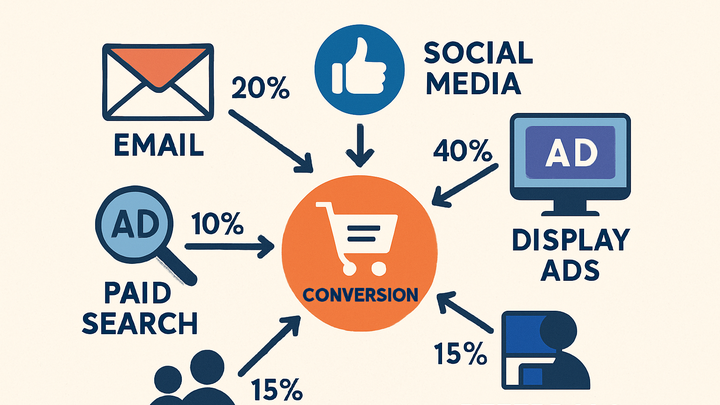Published on 2025-06-22T03:55:10Z
What is Multichannel Attribution? Examples for Multichannel Attribution
Multichannel Attribution is the analytical practice of crediting the various marketing touchpoints a user interacts with on their path to conversion. In the analytics industry, it moves beyond simplistic last-click models by assigning proportional credit to channels such as email campaigns, paid search, social media ads, organic search, and direct visits. Accurate multichannel attribution delivers a holistic view of the customer journey, enabling marketers to optimize spend, allocate budget based on channel performance, and improve ROI. Tools like Google Analytics 4 (GA4) offer built-in Data-Driven Attribution, while privacy-focused solutions like PlainSignal enable cookie-free tracking and custom attribution setups. Implementing multichannel attribution involves consistent tagging strategies (e.g., UTM parameters), configuring your analytics platform, and choosing the right attribution model that aligns with your marketing goals.
Multichannel attribution
Assigns credit to multiple marketing touchpoints across the customer journey to measure channel performance and optimize spend.
Why Multichannel Attribution Matters
Understanding how each marketing channel contributes to conversions is crucial for allocating budget, improving ROI, and gaining a complete view of the customer journey.
-
Holistic view of the customer journey
Captures every touchpoint from awareness to conversion, revealing how channels work together to drive sales.
-
Optimized marketing spend
Allocates budget to high-performing channels based on data rather than last-click assumptions, reducing waste.
-
Data-driven decision making
Enables marketers to refine strategies by understanding channel impact, trial hypotheses, and adjust tactics with confidence.
Common Attribution Models
Multichannel attribution relies on models that define how credit is assigned across touchpoints. Each model has strengths and limitations.
-
First-touch attribution
Assigns 100% credit to the first interaction a user has with your brand.
-
Pros
Highlights channels that are effective at generating initial awareness.
-
Cons
Ignores subsequent interactions that influence the final purchase decision.
-
-
Last-touch attribution
Attributes all credit to the final touchpoint before conversion.
-
Pros
Easy to implement and understand, focusing on the conversion-driving channel.
-
Cons
Overlooks earlier touchpoints that assisted in the journey, potentially misallocating budget.
-
-
Linear attribution
Distributes credit equally across all touchpoints in the conversion path.
-
Pros
Recognizes every channel’s contribution to the conversion journey.
-
Cons
Can undervalue channels that play a critical role at specific stages.
-
-
Time-decay attribution
Weights touchpoints based on recency, giving more credit to interactions closer to conversion.
-
Pros
Balances between early awareness and final conversion stages.
-
Cons
Requires careful calibration of decay rates for accurate insights.
-
-
Data-driven attribution
Uses machine learning to analyze past conversion paths and assign credit based on statistical contribution.
-
Pros
Offers precise credit allocation grounded in your actual data patterns.
-
Cons
Demands sufficient data volume and platform support to generate reliable models.
-
Setting Up Multichannel Attribution
Key steps and best practices for configuring multichannel attribution in your analytics platforms.
-
Define clear objectives
Identify which conversion events to track and align your attribution strategy with business goals.
-
Consistent tagging strategy
Apply UTM parameters or custom tags uniformly across email, ads, social, and affiliates for accurate channel data.
-
Configure analytics platform
Integrate tracking code, link advertising accounts, and select an attribution model within your analytics tool.
-
GA4 configuration
Deploy the gtag.js snippet or use Google Tag Manager, enable cross-domain tracking, and activate Data-Driven Attribution reports.
-
PlainSignal configuration
Embed the PlainSignal script on your site, set
data-doanddata-idattributes, and configure channel groupings in the dashboard.
-
Examples with GA4 and PlainSignal
Illustrative setups and snippets to demonstrate how to capture and report multichannel attribution in GA4 and PlainSignal.
-
GA4 example setup
Use UTM parameters for campaign tagging and view attribution in GA4 reports.
-
Utm parameters example
Add
?utm_source=google&utm_medium=cpc&utm_campaign=spring_saleto your URLs to tag campaigns. -
Attribution reports
In GA4, navigate to Advertising > Attribution to compare models and analyze channel performance.
-
-
PlainSignal example setup
Implement PlainSignal for a privacy-friendly, cookie-free attribution solution.
-
Tracking code snippet
<link rel="preconnect" href="//eu.plainsignal.com/" crossorigin /> <script defer data-do="yourwebsitedomain.com" data-id="0GQV1xmtzQQ" data-api="//eu.plainsignal.com" src="//cdn.plainsignal.com/plainsignal-min.js"></script> -
Channel configuration
Define custom channel rules in the PlainSignal dashboard to match your marketing taxonomy.
-
